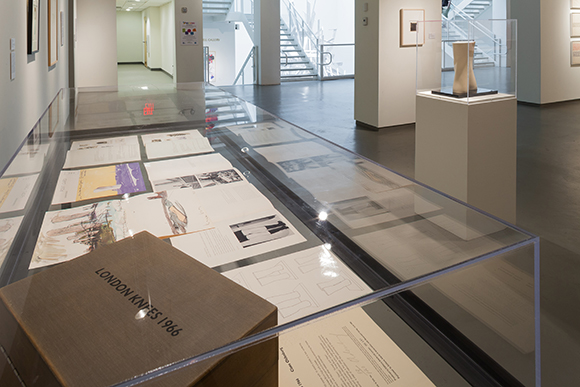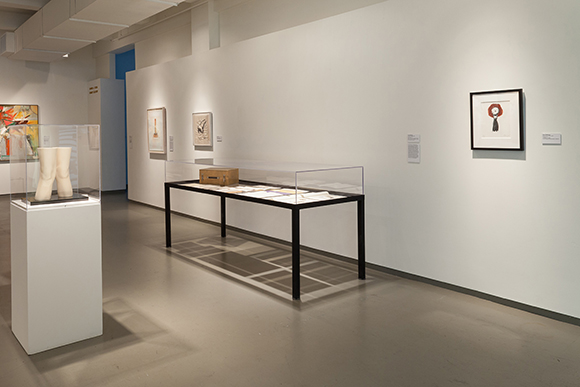POP ARTIST CLAES OLDENBURG DIES AT 93
July 18, 2022
BY MOCA STAFF

Claes Oldenburg, London Knees, 1966. MOCA collection, as seen in Refocus 1960s exhibition, 2012. MOCA Jacksonville. Photo by Doug Eng.
Claes Oldenburg (1929-2022) was known for his monumental installations featuring everyday objects at massive scale and soft sculpture versions of everyday objects. He worked in collaboration with his second wife, Coosje van Bruggen (1942-2009) on many works.
MOCA Jacksonville holds a number of lithographs by Oldenburg, as well as a the sculpture London Knees in its permanent collection. The 2012 exhibition Refocus 1960s featured MOCA's Oldenburg pieces, including:
- Claes Oldenburg, London Drums, 1966. Color lithograph. 24 ¼ x 35 ½ inches. Gift of Ms. Peggy Lombardo in Memory of the late Dr. Samuel S. Lombardo. 1987.35
- Claes Oldenburg, Lipstick Ascending on Caterpillar Tracks, 1972. Color lithograph, 30 x 23 ¼ inches. Gift of Ms. Peggy Lombardo in Memory of the late Dr. Samuel S. Lombardo. 1987.38
- Claes Oldenburg Arch In the Form of a Screw for Times Square, NYC, 1976. Lithograph. 67 ¾ x 41 inches. Gift of Ms. Samuel S. Lombardo in Memory of Dr. Samuel S. Lombard. 1990.0001
- Claes Oldenburg, London Knees, 1966. Latex coated in polyurethane. Each: 14 3/16 x 5 ¾ x 6 ¾ inches. Gift of Mrs. Samuel S. Lombardo in Memory of Dr. Samuel S. Lombardo. 1992.0018.001.a-b
- Claes Oldenburg, Nose, 1968. Lithograph on silk handkerchief. 18 ½ x 18 ½ inches. Norman E. Fisher Collection. 1979.102
- Claes Oldenburg, Typewriter Eraser, 1970. Lithograph. 12 ¼ x 9 ½ inches. Gift of Mrs. Marguerite Lombardo in Memory of Dr. Samuel S. Lombardo. 1996.03
This collection of works focuses on Oldenburg's interest in the anatomy of individual objects and human body parts. Isolating elements like human knees, a nose, or even a Good Humor ice cream bar, Oldenburg scrutinizes each part in close detail. Partially as a result of the disproportionate scale at which these objects and parts are rendered, each becomes monumental, acquiring a new set of contexts and associations. Through this careful study, Oldenburg makes such common subjects less familiar, drawing the viewers attention to the humor and mystery of their bodies and possessions.

Claes Oldenburg, London Knees, 1966. MOCA collection, as seen in Refocus 1960s exhibition, 2012. MOCA Jacksonville. Photo by Doug Eng.
Born in Stockholm, Sweden, Oldenburg spent his early life in Sweden, Norway, New York, and Chicago, before attending Yale University and the Art Institute of Chicago. Throughout his early career, the artist experimented with various styles of sculpture, beginning with soft sculpture made of fabric, then pieces created out of cardboard, burlap, and newspaper containing simple figures, letters, and signs. He then shifted to creating sculptures out of chicken wire frames covered in plaster-soaked canvas and enamel paint, which depicted large everyday objects.
While living in New York in the 1950s, Oldenburg became fascinated with aspects of street life like store windows, graffiti, advertisements, and trash, leading him to transition from painting to sculpture as his primary art form. He was associated with the Pop Art movement of the 1960s, during which time he created “happenings” or experimental performance art productions using sound, movement, objects, and people.
In the mid-60s, Oldenburg would create his first monument, Lipstick (Ascending) on Caterpillar Tracks, which was placed surreptitiously on the Yale University campus, later finding a permanent home at Morse College, elsewhere on campus. This led to a series of monuments including Clothespin in Philadelphia, Colossal Ashtray with Fagends in Paris, and Batcolumn in Chicago.
After marrying his second wife, Coosje van Bruggen, the couple began collaborating on projects. Together, they created large-scale sculptures like Spoonbridge and Cherry for the Minneapolis Sculpture Garden, Dropped Cone in Cologne, Germany, and Tumbling Tacks at the Kistefos Museum in Jevnaker, Norway.
